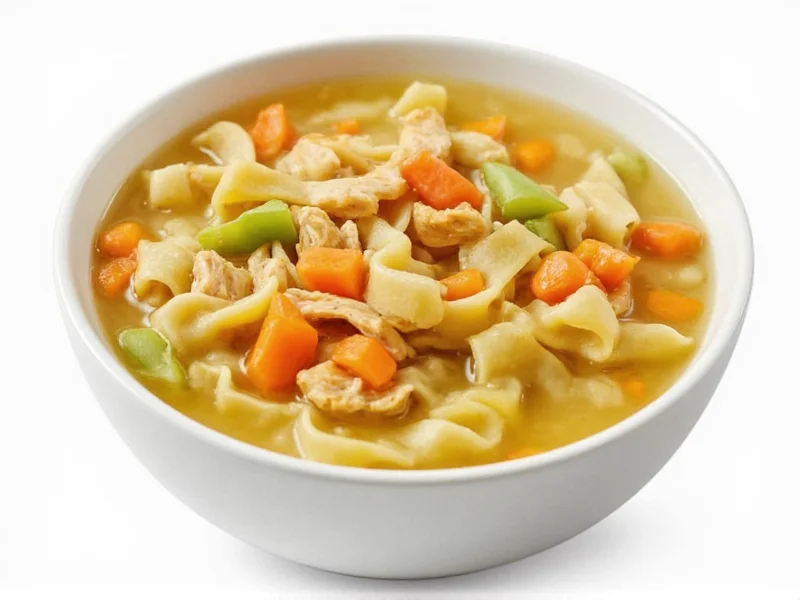Understanding the precise calorie count in chicken noodle soup requires examining multiple factors that influence nutritional content. This comprehensive guide provides accurate information for both store-bought and homemade varieties, helping you make informed dietary choices while tracking your daily caloric intake.
Factors That Determine Calorie Content in Chicken Noodle Soup
The calorie count in chicken noodle soup isn't fixed—it fluctuates based on preparation methods, ingredients, and serving sizes. Commercial products maintain more consistent nutrition facts, while homemade versions offer greater variability but also more control over nutritional content.
Commercial vs. Homemade Variations
Canned and packaged chicken noodle soups generally contain fewer calories than homemade versions because manufacturers often reduce fat content to extend shelf life. However, this frequently comes with higher sodium levels. When preparing soup at home, you control every ingredient, allowing for customized calorie management.
Serving Size Considerations
Always check serving sizes when comparing nutritional information. Many cans contain 2-3 servings despite being a single container. A standard serving equals one cup (8 fluid ounces or 245 grams), but some products define servings differently, potentially misleading calorie calculations.
| Brand/Product Type | Calories per Cup (245g) | Total Fat (g) | Sodium (mg) |
|---|---|---|---|
| Chicken Noodle Soup (Canned, Regular) | 70-85 | 2.0-3.5 | 700-900 |
| Reduced-Sodium Canned Version | 65-80 | 1.5-3.0 | 400-600 |
| Homemade (Standard Recipe) | 90-150 | 3.0-6.0 | 500-700 |
| "Light" or Low-Calorie Version | 45-60 | 0.5-1.5 | 500-750 |
Nutritional Components Beyond Calories
When evaluating chicken noodle soup's nutritional profile, consider these additional factors that impact overall dietary value:
Protein Content
A typical serving provides 4-7 grams of protein, primarily from chicken and sometimes added legumes. Higher protein content increases satiety, making soup more filling despite moderate calorie counts.
Sodium Levels
Most canned varieties contain 700-900mg sodium per serving (30-40% of daily recommended limit). Reduced-sodium options cut this by 30-40%. Homemade versions typically have lower sodium when prepared without added salt.
Carbohydrate Composition
Noodles contribute most carbohydrates (10-15g per serving), with minimal fiber (1-2g). Whole grain noodle substitutions can increase fiber content to 3-4g while maintaining similar calorie counts.
Creating Lower-Calorie Chicken Noodle Soup
You can significantly reduce calories in homemade chicken noodle soup while enhancing nutritional value:
- Use skinless chicken breast instead of thigh meat to cut fat content by 50%
- Replace half the noodles with spiralized zucchini or shirataki noodles
- Add extra vegetables like carrots, celery, and spinach for volume without significant calories
- Skim fat from broth before adding other ingredients
- Use low-sodium vegetable broth as a base to control sodium levels
Reading Nutrition Labels Effectively
When purchasing canned chicken noodle soup, examine these critical elements on nutrition facts labels:
- Verify the actual serving size versus container size
- Check "Total Fat" section—look for products under 3g per serving
- Compare sodium content across brands (aim for under 700mg)
- Review ingredient list for artificial preservatives or flavor enhancers
- Consider fiber content as an indicator of whole food ingredients
Calorie Context Within Daily Nutrition
A single serving of standard chicken noodle soup represents approximately 3-5% of a 2,000-calorie daily diet. This makes it an excellent option for a light meal or starter course when monitoring overall caloric intake. The soup's combination of protein, carbohydrates, and hydration provides balanced nutrition without excessive energy density.
Common Misconceptions About Soup Calories
Many consumers mistakenly believe all canned soups are high-calorie options. In reality, traditional chicken noodle soup ranks among the lowest-calorie prepared soup varieties. Cream-based soups typically contain 2-3 times more calories per serving than broth-based options like chicken noodle.











 浙公网安备
33010002000092号
浙公网安备
33010002000092号 浙B2-20120091-4
浙B2-20120091-4